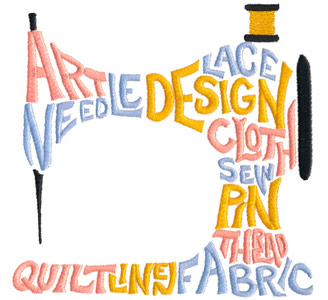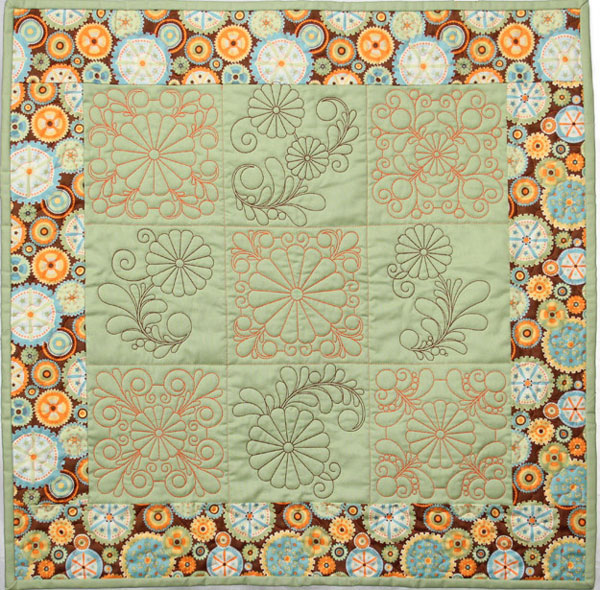Machine Embroidery Designs and Formats
Are you new to machine embroidery and have questions about designs and formats? Would you like to embroider different types of designs in your embroidery machine but are not sure which ones to use? There are a variety of formats and applications for those designs. Let’s take a look at the various designs and formats, and simplify it for you.
Classic Embroidery Designs
The classic embroidery design features tatami fill stitches and is the most common type of machine embroidery. There are many designs in various categories, such as holiday, floral, children, animals, etc. for your many projects. The stitch count in these types of designs will require at least two layers of stabilization with the fabric. Here are samples of designs from some of the different categories: Christmas Tree from Retro Holiday by Indygo Junction #80054, Yorkie from Beloved Dogs by Kathleen Keil Hill #80188, and Zinnia from Breezy Blooms by Susan Rooney #80065.

Another basic type of stitch found in embroidery designs is satin, which is usually seen in letters and numbers found in your embroidery machine and outlines for appliques. An example of satin stitching is the Word Art Sewing Machine from Word Art #12770.

There are many other different types of stitches and fills which are used in machine embroidery designs. Just like in hand embroidery, there are backstitches, stem stitches, satin stitches, special satin stitches, cross-stitches, candlewicking stitches, and decorative stitches. Here are a couple of examples of decorative stitch-type embroidery designs, the Christmas Tree 2 and Peace designs from Seasonal Stitchery #12515.

Applique Embroidery Designs
Another type or technique of machine embroidery designs is applique. The applique technique features fabric with satin stitches, zigzag stitches, or decorative stitches anchoring down a piece of fabric to the background fabric. To find an applique design look for the word “applique” in the name of the design. Also, look for placement stitch, tackdown, and cover stitch being used in the thread chart. Many times if it is pre-cut applique, the applique pattern pieces will also be included in the thread chart. There are different types of applique as well. Read more information about different applique types - Trim in Place Applique and Pre-Cut Applique. Here are a couple of examples of applique designs, the Springtime Mushroom Applique design from Springtime Appliques #12562 and the Swallow Applique from Birds of a Feather by Kaye England #80057.

Freestanding Lace & Applique Designs
Freestanding lace designs have been digitized in a particular fashion so that when the wash away stabilizer is removed, the threads of the design are left standing and intact. Flowers, baskets, ornaments, and jewelry are just a few freestanding lace designs. The Freestanding Lace Easter Basket #12584 is pictured here.

Structures can also be created using the freestanding lace and applique techniques, which adds stability. Read about building a Freestanding Applique here. The Freestanding Lighthouse #12567 and the Christmas Village Schoolhouse with Well #12518 are examples of freestanding lace and applique structures.

Quilting/Linework/Redwork Embroidery Designs
This category of designs features a triple stitch or outline stitch in one color to create the embroidery design. The stitch count is low compared to other designs. The quilting embroidery designs can be stitched on a single layer of fabric, but can also be stitched through the layers (quilt top, batting, and backing) to “quilt” the layers together. Quilting Feather Daisies #12521 features nine outline quilting designs used to create this small wall hanging.

Linework and Redwork embroidery designs are similar to quilting designs; however, they can feature multiple colors in the design. An example is the designs in Friendly Owls #12550.

In the Hoop/Stitch n Turn Embroidery Designs
In the Hoop embroidery designs are typically a project that is completely stitched in the hoop. There are many fun projects, such as zippered pouches, door hangers, mug rugs, and cup koozies… just to name a few. The zippers in the zippered pouches are stitched in the embroidery machine, which is cool! It is fun to stitch a project and have it completely ready to go when it is removed from the stabilizer. Here are a couple in the hoop collections: In the Hoop Zippered Pouches #12519 and In the Hoop Classic Door Hangers #12582.


The Stitch 'n Turn embroidery designs differ just slightly as the majority of the project is stitched in the hoop, but most require stuffing and hand stitching the opening closed after the project is removed from the stabilizer. The Stitch ‘N’ Turn Dolls #12544 is an example of that type of project.
Embroidery Design Formats
That breaks down some of the different types of embroidery designs that are available. Now let’s take a quick look at the embroidery design format. It is important to know what machine and model number you have in order to use the correct design format. Different embroidery machines require different embroidery design formats which are proprietary to that sewing machine company, and different models of machines may use a different design format. The sewing machine company will share what format works best for the model of machine you own. Be sure and write it down so you have that information handy when you download or purchase designs.
At OESD, we give you multiple formats when purchasing our designs, whether it is through instant download or a shipped CD. The design formats we offer are VIP, , ART, DST, EXP, HUS, PES, JEF, and XXX. If your embroidery machine format is not listed, using embroidery conversion software may be a good option. The software will convert the design to the format that is needed.
Factors to remember if your embroidery machine is not reading the design are as follows:
- The correct format is being used
- The correct method of getting the design to the machine is used – most machines will use a variety of methods in reading the design
- The size of the design is too large
These are the main things to check, and if there are still problems then check with your local sewing machine dealer.
The variety of designs and formats can be overwhelming at first, but when breaking them down into smaller categories it makes it simpler to make a decision and know which format to use.
The most important aspect of machine embroidery is to have fun! Learn a new technique or type of design every so often. There are many fun and exciting projects and embroidery designs to stitch. Remember to write down which formats work on your machine. And when purchasing a new embroidery machine be sure you know what format will work best. If you have additional questions, contact us at support@oesd.com.
This material is © OESD, LLC, and may not be reproduced or published without permission.
